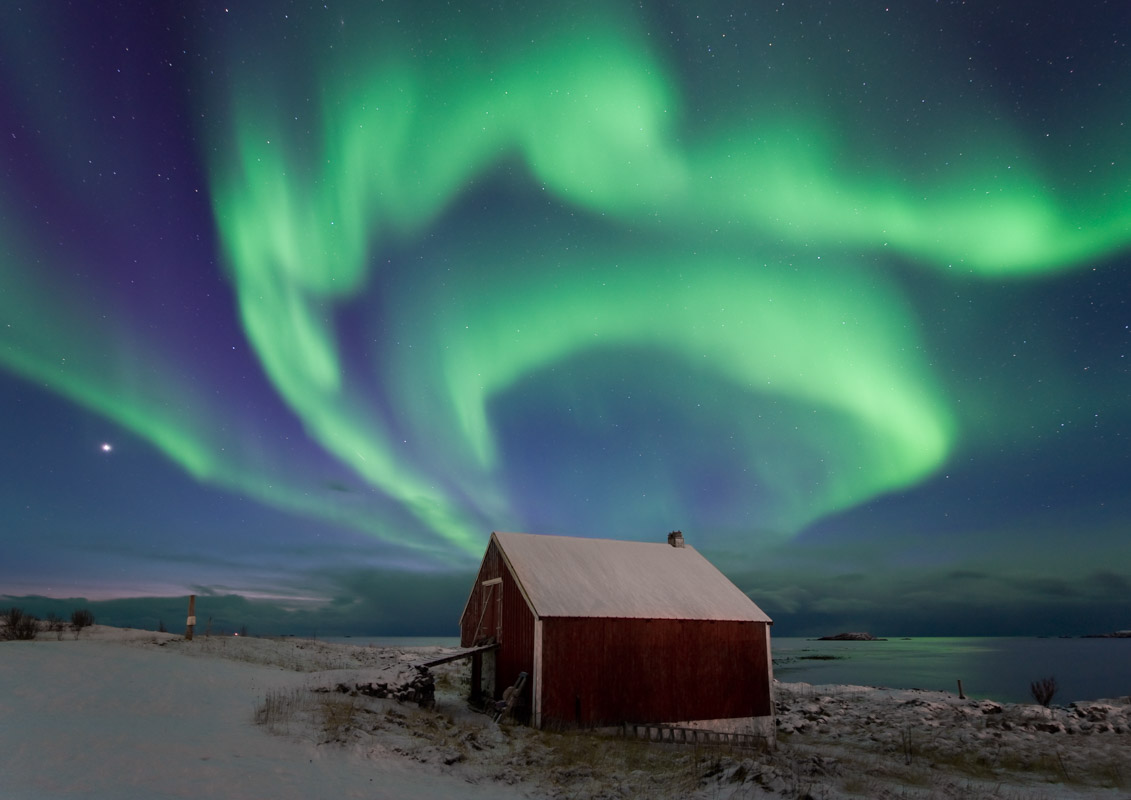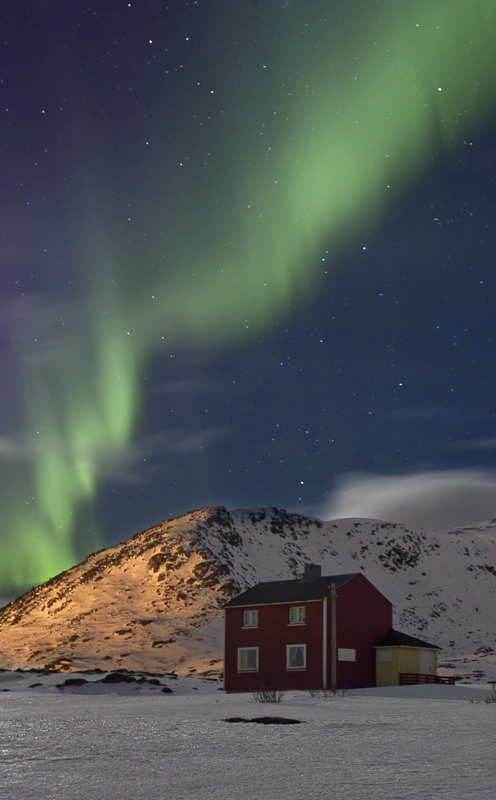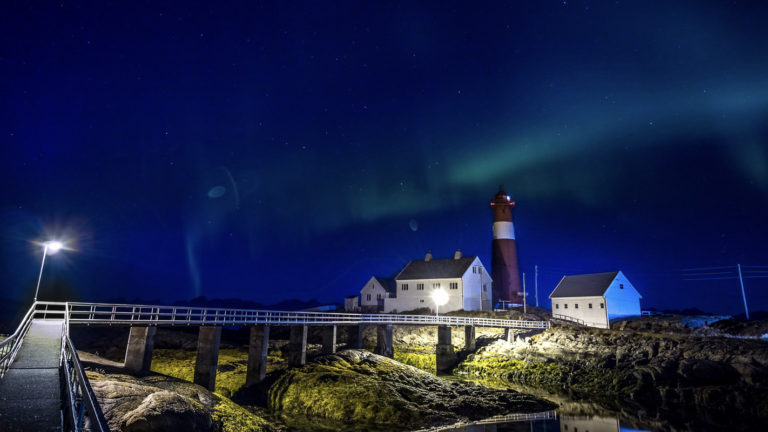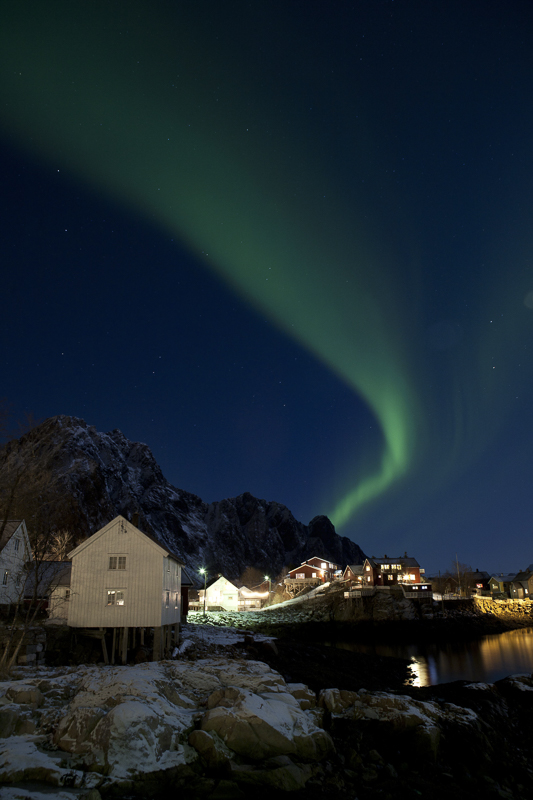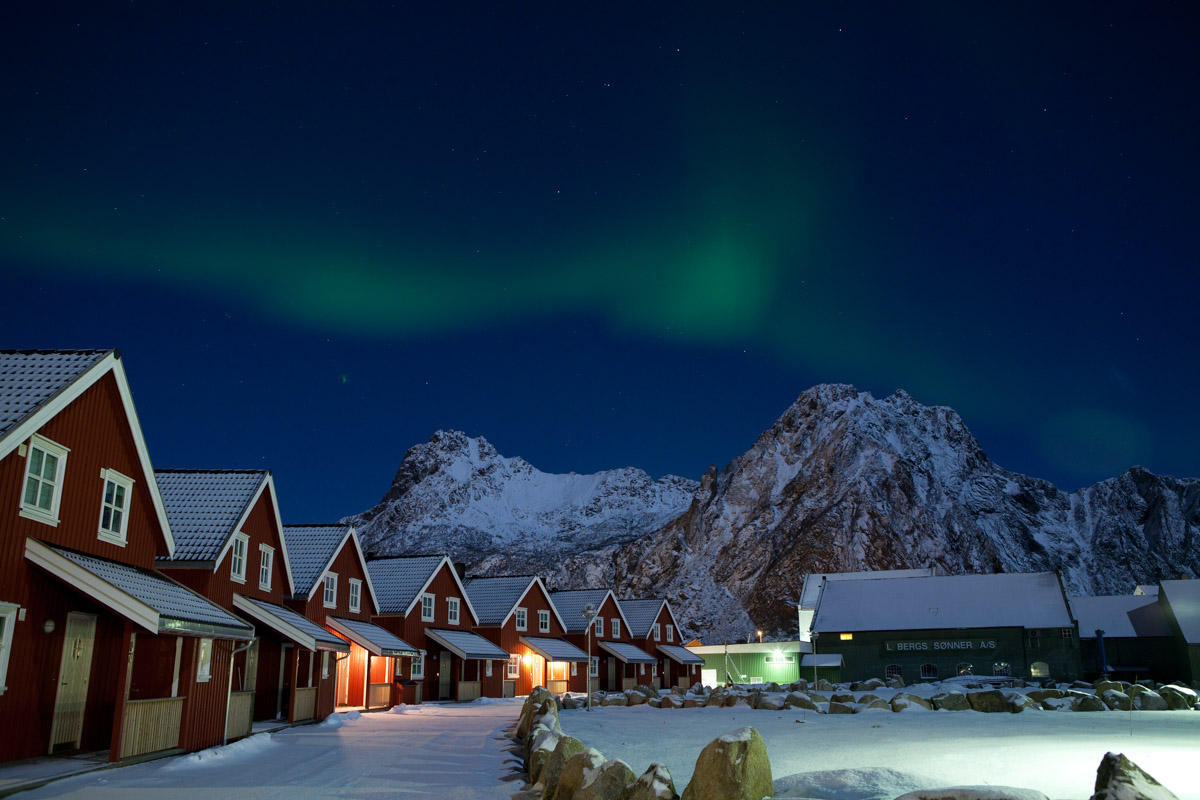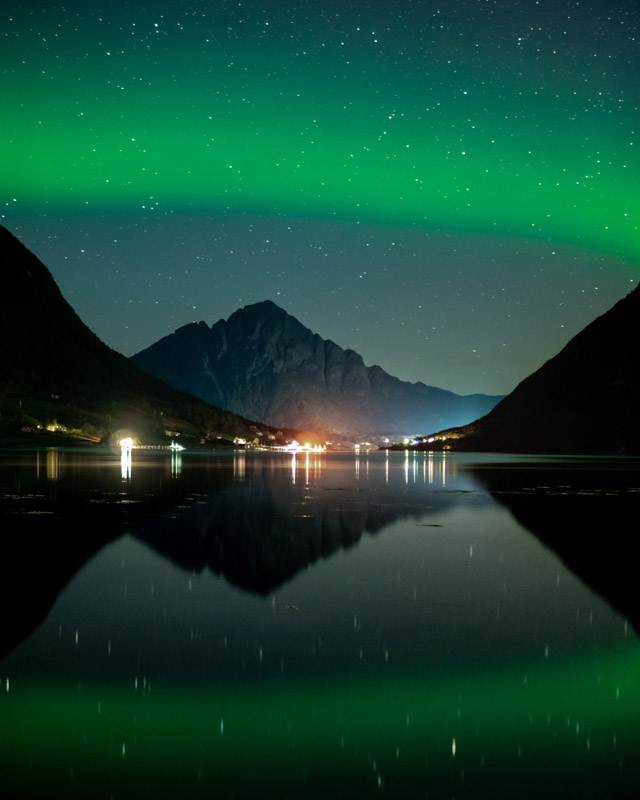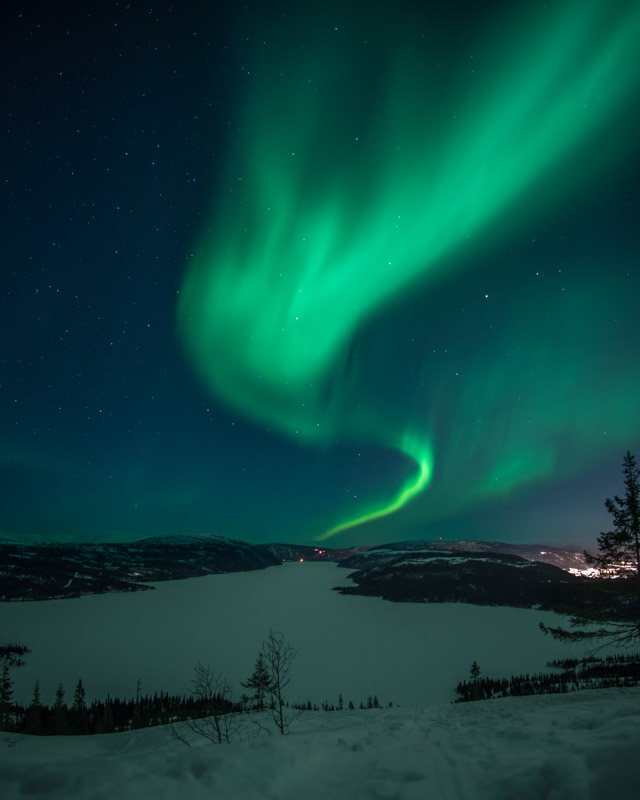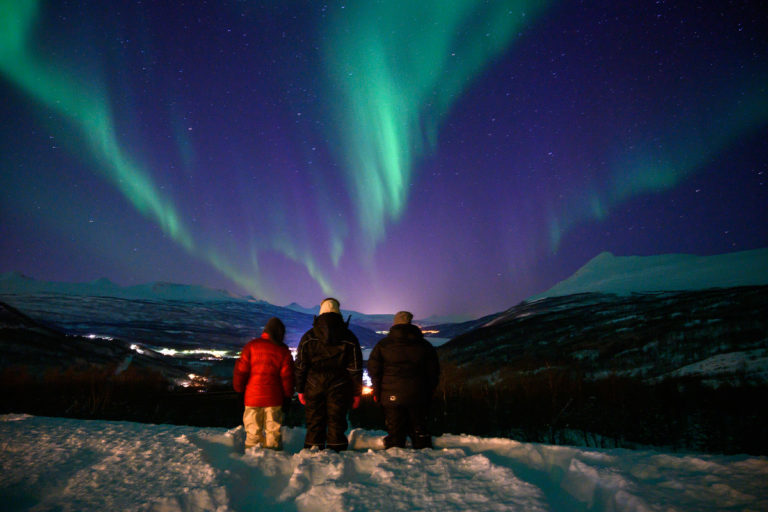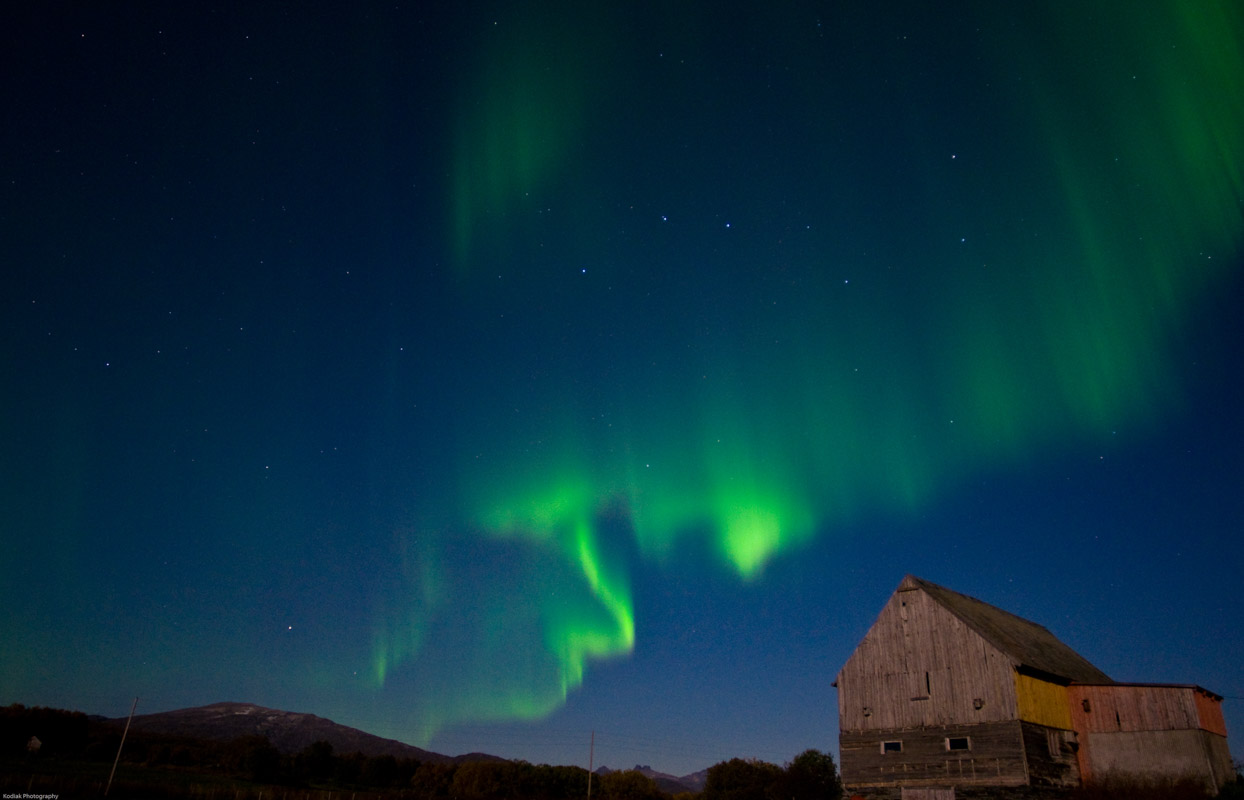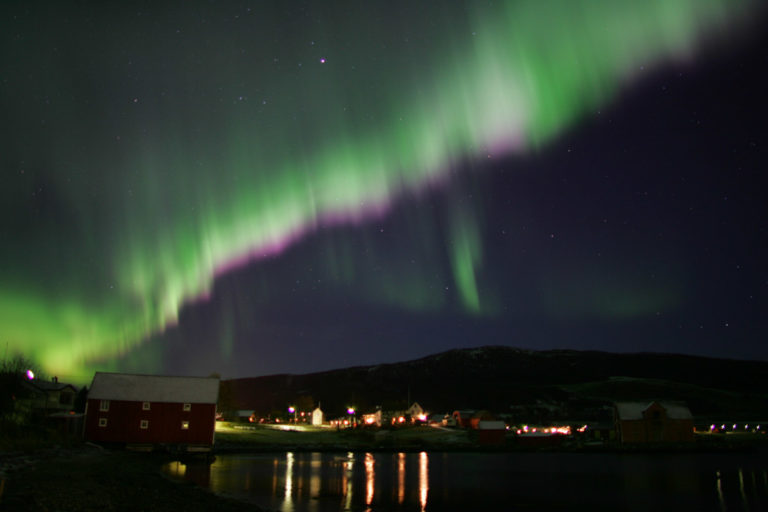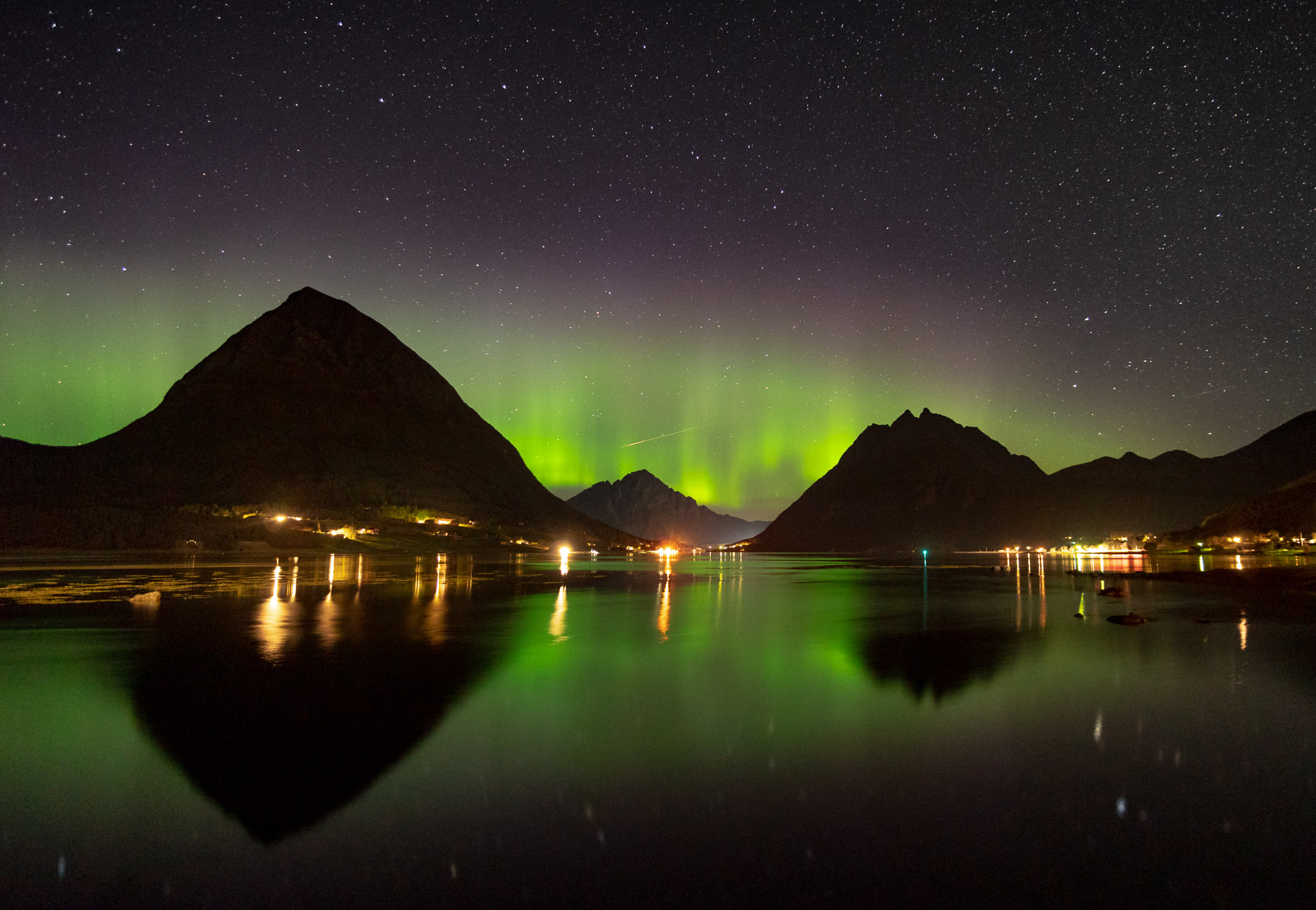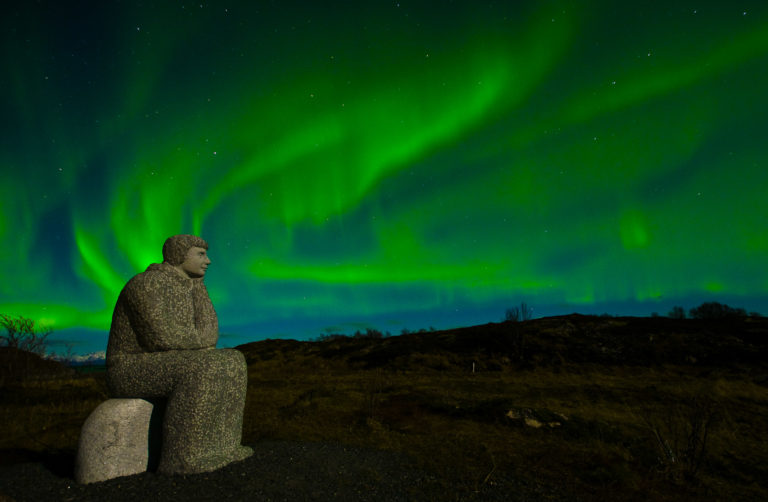Spend a winter week under the Northern Lights oval. Relax during the day and be ready for the lights in the evening.
Nobody knows when the lights are going to turn up. Until now, most Northern Lights seekers have gone to wherever there are Northern Lights guides that can take you out into the night. They are skilled and dedicated, and often find Northern Lights even on the most difficult night. However, one often ends up spending hours in a car, sometimes without any result. If your office days have been stressful lately, that’s the last thing you need.
Hiring a holiday house means being on your own under the Northern Lights
If you spend your allotted winter holiday week in your own self-catering holiday house, you can spend your days relaxing, reading and exploring the area. The nights, however, are dedicated to the celestial diva. The hours between 6pm and 2am are the most active and given clear skies you should have no programme but the lights.
Be ready for the Northern Lights every evening
Look out on the open sky from 6pm onwards. Photographers mount the tripod on the terrace, keep the camera batteries warm and go in and out to the terrace to scan the night sky. Warm clothes should be on the ready, but don’t put them on. You risk sweating indoor and freeze once the lights are out. Whenever the Queen of the Nightsky decides to show up, you’re ready to capture her.
..or go for a Northern Lights walk…
Another option is to go for a long walk. Put on the layers, cover head and hands, remember the reflective and just walk. The Northern Lights are a 100 km above us, so it doesn’t really matter if you’re here or around the next headland. You can thread carefully along the municipal cross country track, or walk the country road winding between the houses. If you walk to the nearest beach, you more hear than see the fjord. Nobody knows when she turns up, and maybe she doesn’t come at all. But at least you have tried.
How are your chances of spotting the lights affected?
Northern Lights tours give the biggest chance of spotting the Northern Lights, night by night. The skillful guides move about in the area between coastal areas and inland valleys, often driving for hours. However, for most of us spending a whole week in a minibus sounds extremely bothersome. If you skip the guided tours, or only go once or twice, and instead hang around your cabin for six or seven nights, you have six or seven possibilities. What gives the biggest chances in the end, nobody can predict. After all, Aurora is a diva that decides herself when to appear.
Have a slow morning and a relaxed day
Sleeping in a little bit, have a long breakfast with several cups of coffee; mornings should be slow-speed only. The first day or two, there is no need to do something beyond a little walk. You could walk to the nearest shop, get your things and have coffee in that corner where the old people of the village meet every day. Don’t sit on their table and give them a friendly nod. And you fit in without imposing yourself.
Go to the beach or the nearest mountain
If you’re familiar with cross country skiing, most places have good conditions for a spin in the ski track. If not, snowshoes are a good idea, and they can often be borrowed or hired. With them, you can walk into deep snow with no trouble for the first time in your life. Finally, in Northern Norway you’re usually close to the sea. The shoreline is the oldest highway in Northern Norway, and you can walk there with regular outdoor shoes.
Explore the area on a slow pace
A rental car is often a good idea, as you can drive around a little. Make it to that viewpoint you found in the local tourist brochure along a winding road along the fjord. Visit the nearby town for coffee and peoplewatching. Local museums often have unimpressive exhibits compared to the British Museum, but they put the place into context and, often unconsciously, tell us what people are proud of locally. There is often plenty to see within a short circumference and very few tourists off season, so this could be an unstressed experience.
Do activities when you feel like it
Before your host decided to let his house, he was thinking: “What if my guests are bored?”. This means he made a phone call to the nearest dog sledding farm, to the Sami family that keep their reindeer in the mountains above the house or to the fisherman who just got the licence to go on sightseeing tours. That means that when you’re ready for it, you can go fishing on a good day, there is dog sledding available and you can eat Sami food in a lavvo. All depending on where you are.
Candle-lit evenings means becoming a bit Norwegian
In Norwegian, there is the word “kos”, which roughly means cosiness, intimacy or atmosphere. The main lamp is turned off and the candles lit. A pot of warm tea is made or a glass of red is poured. The TV is turned off, and laptops and mobile phones are stowed away. Togetherness is the point here, snug up with your significant other, play a board game with the kids or cultivate the art of conversation with your travel mates. When storms rage, and the chances of Northern Lights are like zero, it’s time for some serious kos.
Holiday homes come in every thinkable shape
There is a variety of different places to rent. The typical “rorbu” is a shack to house fishermen during seasonal fishing. Today, these traditional houses are revamped and often equipped with mod-cons. Many holiday homes labelled “rorbuer” og “sjøhus” (Sea house) are actually modern and very comfortable. The Norwegian second home, the “hytta”, can be anything from a simple shack with a natural toilet and well water to comfortable, and they are often hired out. On the countryside, people build new, modern houses and hire out the old farmhouse as a holiday let. There are lighthouses and historical houses that are kept alive by being hired out. Small holiday resorts usually have a few houses or huts together. Often restaurants, bars and activities are available, but not compulsory.
Isn’t the weather dangerous?
Raging storms of the roof-lifting kind are often reported from the North. A reporter from the local new agency shouting into the microphone because of the gales; it looks threatening and dangerous. But now we need to let you in on a little secret; storms are on the average fiercer around the North Sea area. It’s just that we Northerners tend to be drama queens about the weather, and nobody can dramatize as we can “the storm shuffled the roof plates like a stack of cards”. Most winter days are undramatic, mild and snowy along the coast, cold and clear in the inland. The houses are built to withstand the occasional gale, so if something with a girl’s or boy’s name is announced, you simply stay home.
Is it dark the whole time?
The only place with total darkness in Northern Norway is Svalbard, where it is dark even at mid-day in December-January. In the polar night at the mainland, you still get to see the landscape in the few hours of wonderful, low light. By late January, the sun is back everywhere on the mainland, and you can expect many hours of full daylight. The period until early April is when you can expect to see the Northern Lights.
Any idea where I should go?
Here is a selection of different options. We do not recommend these places over other, unmentioned places, we just want to give ideas to different kinds of places in different geographical areas. A bit of exploration to find YOUR refuge for a week could be a labour of love. We have included links to various local tourist boards that have even more ideas on their pages.
The huts at Manshausen resort in Steigen are award-winning architecture providing fabulous views to the Lofoten Islands. Do nothing at all, or have gourmet food in their restaurant and do organised activities. After all, the owner has been several times on skis to the North Pole.
What are the Northern Lights?
Sortbrysttjernkoia in Pasvik, right on the Russian border, is found in the deep forests. No bathroom, no water and no electricity, this is all done in the traditional way. Get clean in the sauna, and spend your days in the deep, frozen forests. For the adventurous kind…
Live in the larder at Røkenes gård: The 250 year old “stabbur” (food storage, larder) at the Røkenes manor just outside the city of Harstad has all mod cons, yet the history is in the walls. Nearby Harstad has excellent food and good attractions, and it’s easy to explore a wide area in the heart of Northern Norway.
Træna Rorbuferie is found in the middle of a thriving coastal community. Small and medium-sized comfortable huts, easy access to bars and restaurants in the village, excursions to the nearby islands; this is perfect for a stay on an island in the middle of the ocean away from it all, yet in sync with the locals.
Hamn i Senja enjoys a fabulous location at a natureal port on the outside of Senja Island is unbeatable. As a part of a small resort, you can make use of a restaurant and a bar. They even have guided tours and activities. Yet, there is plenty of seclusion in the hut, and the fantastic scenery around is easy to explore on your own.
Jakobsbakken is an old mining community. The old quarters have been turned into rather luxurious apartments. Go here for cross country skiing and Northern Lights in a remote mountain area near Bodø.
Nyksund is a forgotten fishing village that has got a new lease of life. Here you can stay in simple studio cabins, look for the Northern lights and get to know this very particular location. It is also an easy starting point for exploring the Vesterålen Islands.
Big Fish Adventure at Hasvik on the big island of Sørøya has modern, comfy huts. They are found in the middle of a fishing village. This is really where you immerse yourself in the local community.
Engholm Husky Design Lodge is a small resort, with log cabins built by your host. Every cabin is different, and your egg holder might be made of reindeer antlers. In the Sami village of Karasjok, it is surrounded by deep pine forests. Dogsledding, skiing, snowshoeing and visits to reindeer heards are on offer, but these things are optional. Very optional.
Garsnes Brygge is your typical purpose-built modern rorbu, with tasteful modern interior behind a traditionally looking façade. With a car, a number of interesting sights are available, yet is is all in a peaceful community on a fjord.
Amtmannsstua Feriehus is a house dating from around 1800. Modern facilities are discreetly fitted into the historic atmosphere. The house is found in Sømna, almost as far south as you can come in Northern Norway, and is suited for anyone seeking a mild, less wintery stay.
Lyngen North are igloo-like glass cabins on the Lyngen Fjord. They are made for Northern Lights observation, and the majestic Lyngen Alps are on the other side of the fjord. The place is easy to combine with stays in Tromsø or Alta.
Månedskarbua in Kongsfjord is a single hut dating from the early 20th c.. “Månedkarbua” means “monthly guy shack”, because it was used to house temporary workers staying a month for the fishing season. The location in the minuscule, historic hamlet of Kongsfjord is remote on the Varanger peninsula, and suited for anyone in need of a relaxed programme.
Lofoten Rorbuhotell has traditional rorbu accommodation right on the waterfront fitted with mod-cons. If you stay here in winter, you are witnessing the busy Lofoten fisheries. Loads of attractions along the outer edge of Lofoten away, along with possibilities for a spectacular storm.
Finnkroken Feriehytter is a small resport where the huts look exactly like the traditional huts Norwegians built in the 50’ies and 60’ies, yet are equipped with mod-cons. It is found in an extremely quiet hamlet near very busy Tromsø.
Aurora Glamping in remote Kokelv is spacious and luxurious. Go there for secluded relaxation, Northern Lights and the chance to explore the furthest north, with Hammerfest, Alta and the North Cape within reach.
